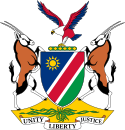| |||||||||||||||||
Presidential election | |||||||||||||||||
| Turnout | 76.05% | ||||||||||||||||
|---|---|---|---|---|---|---|---|---|---|---|---|---|---|---|---|---|---|
| |||||||||||||||||
 Results by region | |||||||||||||||||
| |||||||||||||||||
 |
|---|
General elections were held in Namibia on 4 and 5 December 1994. Each registered voter could poll two votes, one for president (the first time a president was to be directly elected) and one for the National Assembly. Both elections were won by SWAPO, which won 53 of the 72 seats in the National Assembly, and whose candidate, Sam Nujoma, won the presidential election by more than three-fourth of the polled votes. [1]

